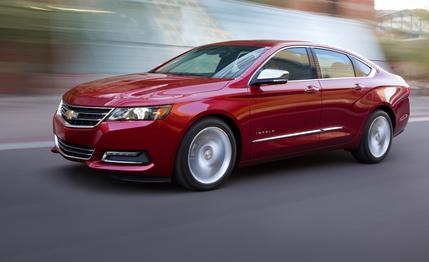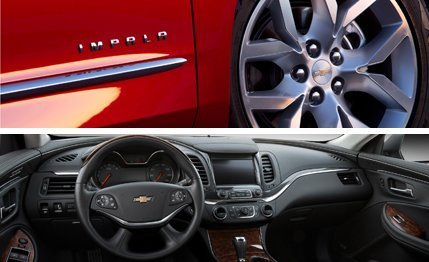 First Drive Review
First Drive Review
The 2014 Impala is like a scarred and once-proud prizefighter who has been down on his luck but now reenters the ring eyeing a big comeback, and it’s Chevy’s newest attraction. This 10th-generation edition of the bow-tie brand’s most enduring nameplate is born with effective fixes for its eight-year-old predecessor’s terminal character flaws. The new Impala’s mission is to rouse the snoozing large-car segment with its combination of envy-me exterior styling, modern underpinnings, and contemporary furnishings while honoring Chevy’s traditional value equation.
The new Impala starts below $30,000 and ranges over $40,000 to challenge its two longstanding domestic rivals—the Dodge Charger and the Ford Taurus—as well as three imports—the Hyundai Azera, the Kia Cadenza (due later this year), and the Toyota Avalon—vying for a share of this half-million-cars-per-year segment. There are three Impala trim levels, wheel sizes, and engines to choose from, plus a few options arranged in a logical staircase. (Impala pricing info here.)
To make the Impala a credible flagship, Chevy replaced the 20-plus-year-old W-platform with the long version of the Opel-designed Global Epsilon chassis. Designer John Cafaro led the team that blessed the exterior with evocative creases and folds, giving the Impala a large street presence in spite of only modest increases over the previous Impala’s basic dimensions. The goal was a shape as classic as that of the seminal ’58 Impala without plagiarizing ancient retro cues.

Trumping the outgoing Impala’s anodyne looks was a snap. The tougher challenge was to bring contemporary vitality into this two-ton four-door sedan without snubbing essential creature comfort, composure, and entertainment necessities. After driving several early-production 3.6-liter V-6 Impalas over Southern California hill and dale, we’re convinced that chief engineer Todd Pawlik’s team has largely succeeded. Agile turn-in, competent dynamics, smart steering, and poise are character traits new to the Impala.
What’s more interesting is that, post-bankruptcy, GM engineers crafted a roadworthy Impala without expensive solutions to the usual ride, handling, roominess, and comfort challenges. Chevrolet didn’t use the special HiPer-strut front suspension employed in the Buick Regal GS, Buick LaCrosse, and Cadillac XTS. Instead of resorting to costly adaptive dampers, the front shocks are carefully tuned conventional twin-tube components. The multilink rear suspension bolts directly to the 111.7-inch-wheelbase (1.2 inches longer than before) unibody.
Shrewdly tuned urethane jounce bumpers and rebound springs supplement relatively soft front coils to provide a plush ride while keeping body motion under control during aggressive maneuvers—at least on the smooth roads we drove in California. Hydraulic suspension bushings in key locations and anti-roll-bar rubbers fortified with metal inserts soften impact strikes without compromising the high lateral stiffness needed for capable cornering. Electrically assisted power steering helps fuel efficiency and provides quick and linear response with appropriate effort buildup but, alas, no real road feel.